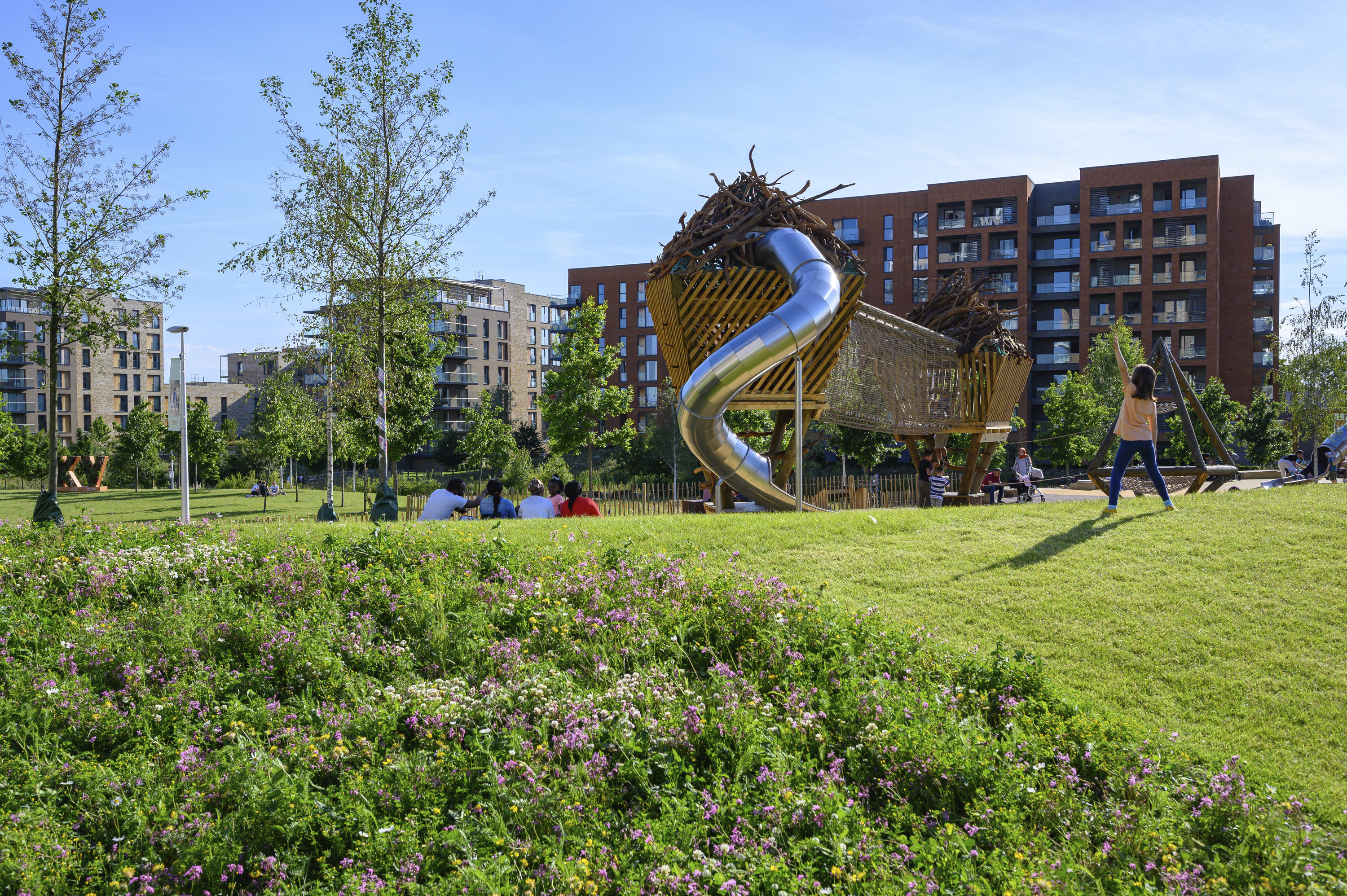North Cator Park

At the source of the chalk stream we have created a 3,000m3 wild play space creating a biophilic experience for ages 0 to 100. Limestone outcrops and climbing walls enclose the space and its play towers. Materials used in the construction have been repurposed and upcycled from standing deadwood trees, air preserved and reused as climbing frames, with redundant Thames jetties used as climbing walls and benches. At Kidbrooke Village we recycled 30,000m3 of site materials that would otherwise have otherwise gone to landfill. This inspired move saves significant resource, reduces offset environmental impact, delivers positive health benefits and creates a rich network of varied habitat types.
Describe the context and brief for this place?
HTA’s Landscape team worked across multiple phases of Berkeley Homes’ Kidbrooke Village, delivering C 5000 new homes from planning to delivery on site, including the redesign of the 8ha Cator Park in collaboration with the London Wildlife Trust.
We responded to the brief with a landscape led vision for Cator Park and the wider Kidbrooke Village, proposing a mosaic of varied habitat, topography and biophilic spaces including lakes, WSUD wetlands, meadows, open amenity and wild spaces.
Drawing upon the history of a lost river that crossed the site and from where the village takes its name, the Lower Kid Brooke, a new chalk stream creates a palimpsest of the ancient waterway as a dry chalk stream winding its way from the north to the south of the park. The chalk stream forms the backbone of the landscape approach, connecting the existing water bodies with a dry riverbed, acting as a path and inviting the public to discover and interact with the natural environment.
At the source of the chalk stream we have created a 3,000m3 wild play space creating a biophilic experience for ages 0 to 100. Limestone outcrops and climbing walls enclose the space and bespoke natural play towers create a dramatic focus the space, materials used in the construction have been repurposed and upcycled from standing deadwood trees, air preserved and reused as climbing frames to greenheart groynes pulled out redundant Thames jetties to be used as climbing walls and benches.
How has this project or intervention contributed to the urban life or user experience of this place?
The vision returns nature to the city and challenges the perception that urban brownfield development cannot
contribute to the wider ecological and biodiversity network whilst creating successful spaces for the community. This new park at the centre of the development will offer a legacy for the local community & London that will bring people together and form a sense of identity.
At Kidbrooke Village we recycled 30,000m3 of site materials that would otherwise have otherwise gone to landfill.
We used this to create dramatic topography in the park that encourages play healthy lifestyles and also allows for a wider range of habitat types, chalk grasslands on south facing slopes and shady woodland glades on the north.
This inspired move saves significant resource, reduces offset environmental impact, delivers positive health
benefits and creates a rich network of varied habitat types. Local children have designed a ‘stepping stone’ trail
made from cast iron from clay reliefs they created with the design team. Play trails, sculptures and structures to
jump, swing and hang from have all been incorporated throughout the space. For older children, there is also a new multi-use games area where they can practice sports like football, tennis, basketball and netball.
We produced two illustrative signs displaying the ecological and biodiversity networks and the History of the area.
We also designed an educational poster for children with activities to learn about the habitat and the history of their neighbourhood.
What do you see as the greatest success of this project?
Good development is all about people. It’s about making life better, creating beautiful homes and putting the
wellbeing of the whole community at the heart of the plan. It’s about creating places people will love as their own and care for long after we’ve all gone.
Cator Park transforms an existing underused parkland into a biodiverse park for people and wildlife, supporting the network of Green Infrastructure beyond the site boundaries, offering social places for the local community to grow.
Biodiversity has a big role in creating healthy, vibrant neighbourhoods for future generations. Designing and
implementing biodiversity net gain goes hand in hand with delivering a climate- change resilient development and in London will typically include habitat creation, diverse naturalistic planting, biodiverse sustainable urban drainage systems and green roofs, and wildlife features such as swift bricks and bee hotels. Not only has nature returned but the parkland transformation has received an overwhelmingly positive response from local residents.
London Wildlife Trust have helped kids discover the natural beauty on their doorsteps. On the Park open day the Trust ran a range of workshops and activities, including teaching willow weaving and pond dipping sessions, where children could discover the incredible creatures and minibeasts that live in Kidbrooke Village’s wetlands. We hope that their work and the biodiversity in the park not only contributes to the health and wellbeing of children but that it also encourages future generations to nurture and protect this special place.
Please share any figures that support your entry – for example, increased dwell time, happiness surveys, foot fall, event attendance, or observed changes in behaviour. Article references or quotes from supporters or reviews in the media may also be included.
Working with the London Wildlife Trust, the Kidbrooke Village development boosted biodiversity on the site by
200%.
Berkeley Homes carried out a resident survey and found 80% said they appreciate how much green spaces there are. For families, these spaces are important in providing opportunities to bond with their children and socialise with other families.
They also found that the residents:
• Want to connect with their neighbours and form a cohesive community.
• Want to learn more about living more sustainably.
Cllr Danny Thorpe, Leader of the Royal Borough of Greenwich: "Having access to green space is important to
encourage active, outdoor lifestyles and it supports healthy physical and mental wellbeing. Cator Park is a fantastic place for everyone right across Royal Greenwich to discover - and with the new play space, there is even more reason to do so."
David Mooney, London Wildlife Trust: "Everything that’s happening at Kidbrooke Village is helping to make it a
more wildlife-rich environment that future generations can enjoy - from the new open spaces to the events and
volunteering sessions that we encourage as many people as possible to join in."
Tony Pidgley CBE, Berkeley Group Chairman: "We have created more than 20 acres of beautiful open space
where people of all ages can get close to nature and enjoy the peace and tranquillity of the great outdoors.”
Local school employee: “Kidbrooke has been transformed! I’m glad to see that effort is being made to improve
access to nature for future generations.”
-
Early bird entry deadline: 15 December 2023
-
Final entry deadline: 25 January 2024
-
Festival of Pineapples: 15-19 April 2024
-
Awards party, London: May 2024
© The Pineapples - Tweak Ltd. 124 City Road, London, EC1V 2NX. Tel: 020 3326 7238
